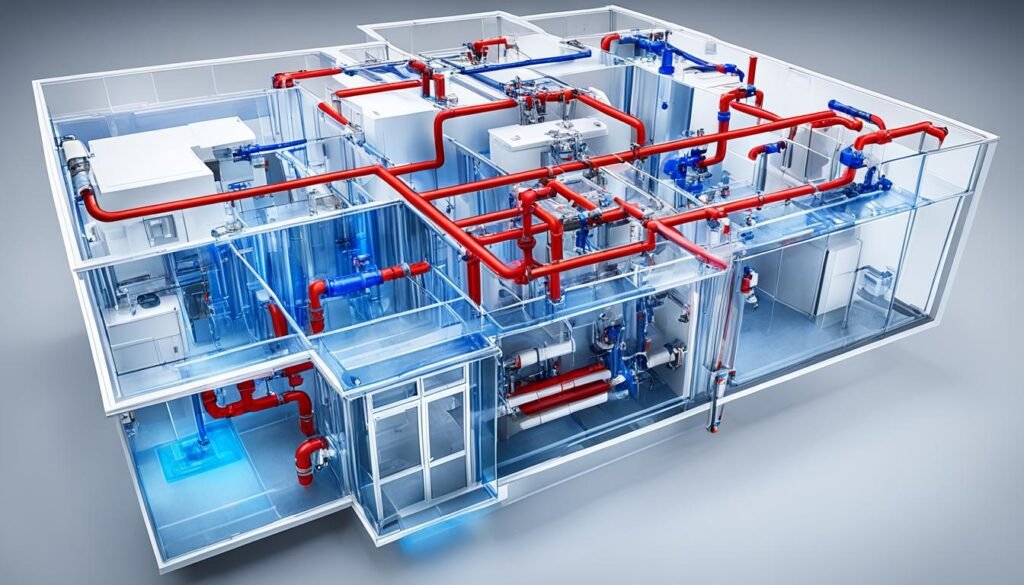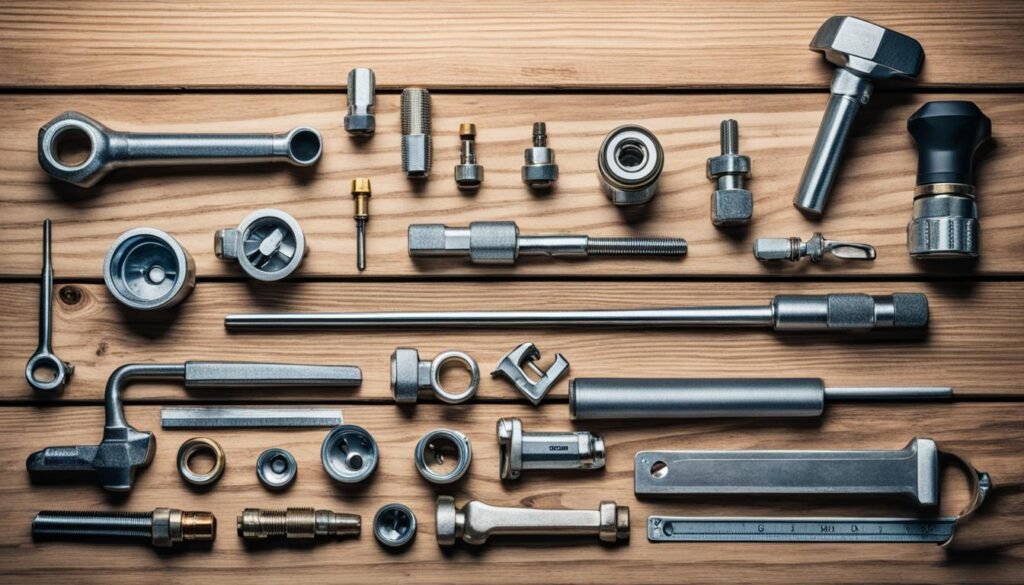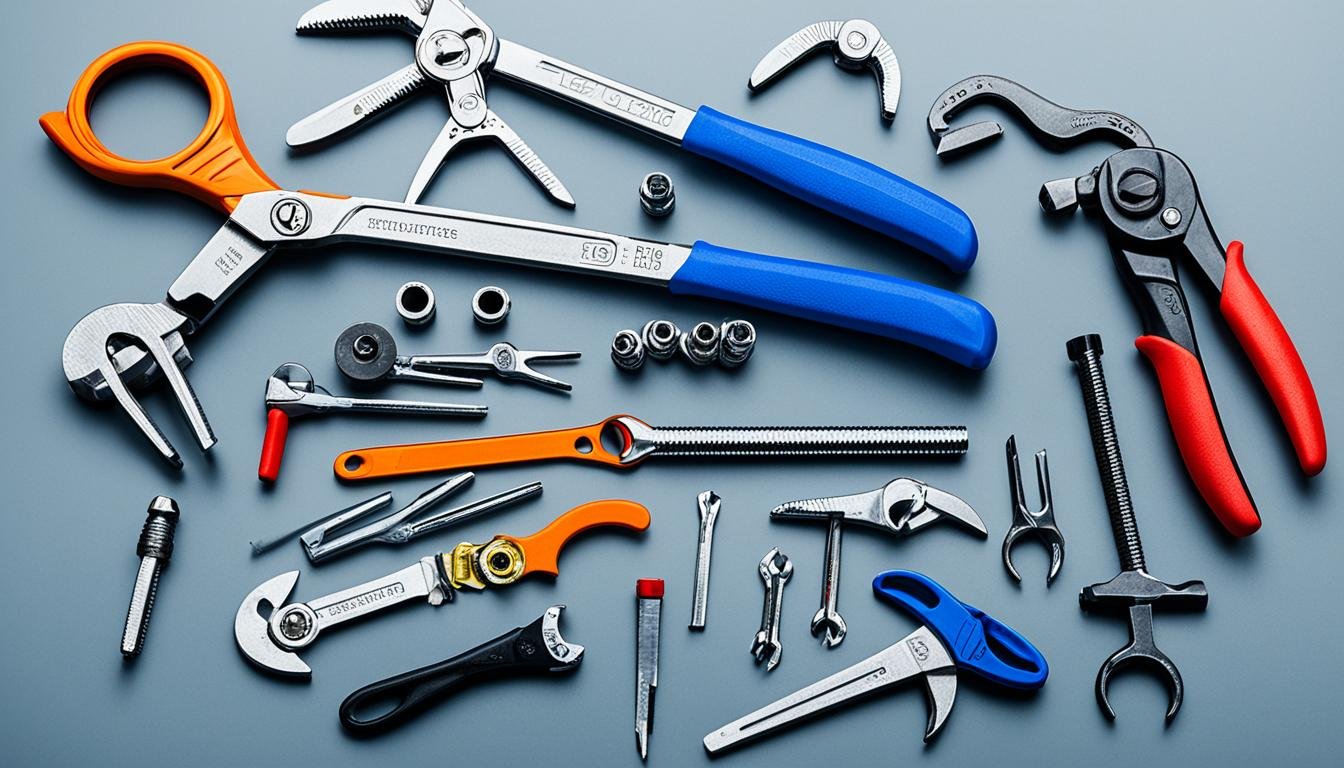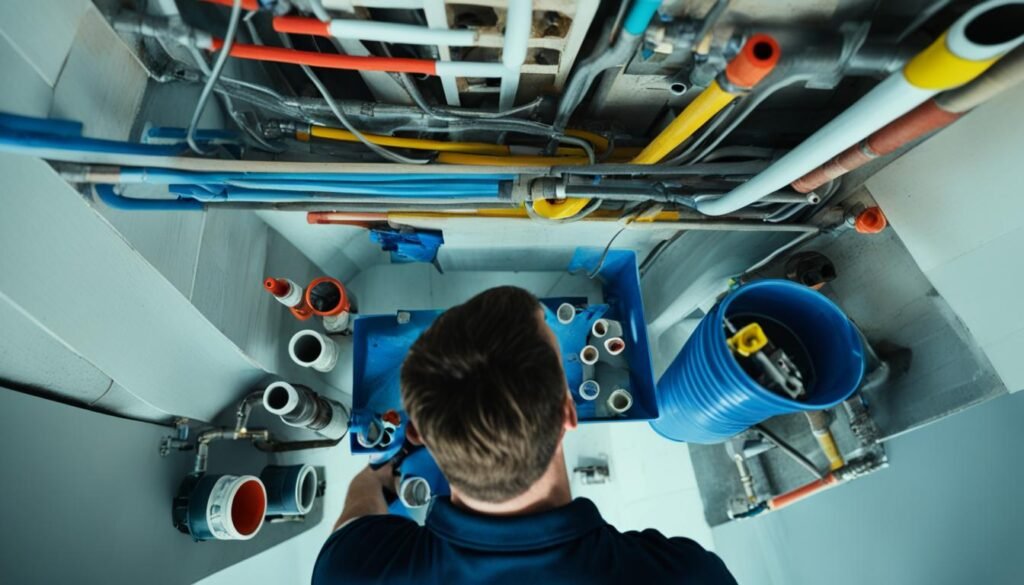Imagine how much you could save by fixing plumbing issues at home. You might save up to 50% by avoiding a professional plumber. Many people, about 60%, choose to fix small problems themselves before calling for help. This choice saves money and helps the environment too. Let’s dive into the world of DIY plumbing and learn to fix things like leaky faucets and clogged drains. By doing so, we’ll save water and protect the planet.
Key Takeaways
- DIY plumbing can save homeowners 30-50% compared to hiring professionals
- Approximately 10% of households have leaky faucets that can be repaired at home
- Fixing a leaky faucet can save up to 1,000 gallons of water per year, resulting in $20-$200 in annual savings
- Eco-friendly approaches like using a plunger can reduce harmful chemical waste by 50%
- Upgrading to a new showerhead can save up to 2,700 gallons of water per year
Understanding Your Home’s Plumbing System
Before you start on any plumbing work, grasp the basics of your home’s plumbing. This system includes pipes, fixtures, and appliances. They bring fresh water in and carry waste out. With a little knowledge, you can tackle DIY projects with more confidence.
Your Home’s Piping Network
Your home’s plumbing starts with the pipe network. It’s made of pipes and valves that move water in and out of your home. The water supply system brings in fresh water, while the sewer system takes out waste. Knowing this helps you find and fix issues easily.
The Water Supply System
Your water supply system brings clean water to your faucets, showers, and toilets. It works with steady water pressure for a constant flow of water. Keeping an eye on this system is important. Regular checks for leaks and the right water pressure are key. This care helps avoid expensive water damage.
The Sewer System
The sewer system removes used water and waste. It includes pipes and sewage lines. These pipes lead to the municipal sewer or a septic system. Learning about the sewer system can save you from major issues like blocked drains. Prompt action on clogs and backups spares you from big plumbing headaches.
Learning about your plumbing system makes DIY tasks easier. Knowing when to call for help is also vital. Keeping your plumbing well-maintained stops water damage. It also keeps your home’s water system working smoothly.

“Plumbing leaks waste 1 trillion gallons of water annually in the US, equivalent to 40 million swimming pools.”
| Plumbing System Component | Key Functions | Maintenance Tips |
|---|---|---|
| Water Supply System |
|
|
| Sewer System |
|
|
Simplest DIY Plumbing Tasks
Leaky faucets, faulty toilet flappers, and clogged sinks are issues you can fix yourself. You just need a few tools and some know-how. By doing it yourself, you save both money and time. Plus, you get to improve your home’s plumbing by Fixing Leaky Faucets or Upgrading Showerheads.
Once you’re confident with these simple tasks, you can take on more. This will grow your plumbing skills. Let’s look at some easy DIY plumbing tasks to keep everything working well at home.
Replacing Toilet Flappers and Repairing Running Toilets
A running toilet is a common issue, usually from a bad toilet flapper. The fix is easy with a Toilet Flapper Replacement. This not only saves water but also money on bills. You might also just need to adjust the fill valve or change the flapper.
Unclogging Sink Drains and Fixing Leaky Faucets
Unclogging Sink Drains might seem tough, but you can often do it yourself. A plunger or drain snake works well. Fixing Leaky Faucets is also an easy DIY job. Just replace the washers or O-rings to stop the leaks.
Upgrading Showerheads and Replacing Kitchen Sink Sprayers
Improving water efficiency in your home is easy with a Upgrading Showerheads. A new, efficient showerhead reduces water use and your bills. Replacing Kitchen Sink Sprayers is quick and boosts your kitchen sink’s use.
Remember, these DIY plumbing fixes are not hard if you’re patient and have the right tools. Learning these skills saves you money, gives you a sense of achievement, and keeps your home’s plumbing in top shape.

“With the right tools and a bit of know-how, homeowners can tackle many common plumbing issues themselves, saving time and money in the process.”
| DIY Plumbing Task | Estimated Cost to DIY | Estimated Cost for Professional |
|---|---|---|
| Fixing Leaky Faucets | $5 – $20 | $50 – $150 |
| Toilet Flapper Replacement | $5 – $15 | $75 – $200 |
| Unclogging Sink Drains | $0 – $10 | $75 – $200 |
| Upgrading Showerheads | $20 – $50 | $75 – $150 |
| Replacing Kitchen Sink Sprayers | $20 – $50 | $75 – $150 |
| Repairing Running Toilets | $5 – $20 | $75 – $200 |
Conclusion
You’ve learned a lot in this guide about DIY Plumbing tasks you can do at home. Knowing your home’s plumbing and having the right tools helps you save money. It also gives you a great feeling of success and keeps your home’s plumbing healthy. Always think of Plumbing Safety and be careful when fixing pipes.
If a Plumbing Emergency happens or the problem seems too big, get help. A professional Plumber has the knowledge to fix things right. Now, armed with the advice in this article, you can handle many Plumbing Maintenance jobs yourself.
Taking on DIY plumbing tasks not only saves you money. It also helps keep your home’s plumbing in good shape. Remember, regular checks and quick fixes can stop big problems later. So, keep up the good work. Enjoy doing it yourself and take pride in keeping your home running smoothly!
FAQ
What are the main components of a home’s plumbing system?
A home’s plumbing has three key parts: pipes for water and waste, a fresh water system for taps, and a sewer system to take away used water. They all work together to keep homes running smoothly.
Can I fix a leaky faucet on my own?
Yes, you can. Fixing a leaky faucet is doable for many people. You’ll need some tools and a guide. Sometimes, just changing a washer can fix it.
How do I unclog a sink drain?
Unclogging a sink is pretty simple. You can use a plunger or a drain snake. Taking apart the pipe under the sink can help if the clog is stubborn.
Can I install a new showerhead myself?
Installing a new showerhead is easy to do. You just unscrew the old one and put the new one on. Make sure it’s tight so it doesn’t leak.
How do I fix a running toilet?
To fix a running toilet, you might adjust the flapper or the water level in the tank. A few tools and some checking are usually enough to get it working right again.
When should I consider hiring a professional plumber?
If a plumbing job seems too big or you’re not sure, it’s time to call a plumber. They have the skills and the gear to fix things the right way. This keeps your home safe and working well.
Source Links
- https://sewerfix.com/plumbing-for-the-diy-enthusiast-projects-you-can-tackle-with-confidence/
- https://showtimeplumbingllc.co/blog/diy-plumbing/
- https://centralplumbing.org/do-it-yourself-plumbing-what-you-cant-do/
- https://happyhiller.com/blog/the-plumbing-basics-understanding-your-home-plumbing-system/
- https://www.veteranair.com/blog/beginners-guide-home-plumbing/
- https://www.bigbplumbing.com/blog/diy-plumbing-projects-guide-to-plumbing-repairs/
- https://www.oatey.com/faqs-blog-videos-case-studies/blog/5-easy-diy-plumbing-fixes-you-can-tackle-yourself
- https://www.aroundthebendplumbing.co.uk/news/easy-diy-plumbing-tasks-you-can-do-yourself/
- https://www.aclass-plumbing.co.uk/10-easy-plumbing-repairs-that-dont-require-a-plumber/
- https://charlietheplumber.com.au/blog/plumber/diy-plumbing-fixes-every-homeowner-should-know/
- https://www.blplumbingserviceinc.com/diy-plumbing/
- https://medium.com/@aroma112050/how-to-undertake-simple-plumbing-tasks-in-your-home-dd011b99f07d




